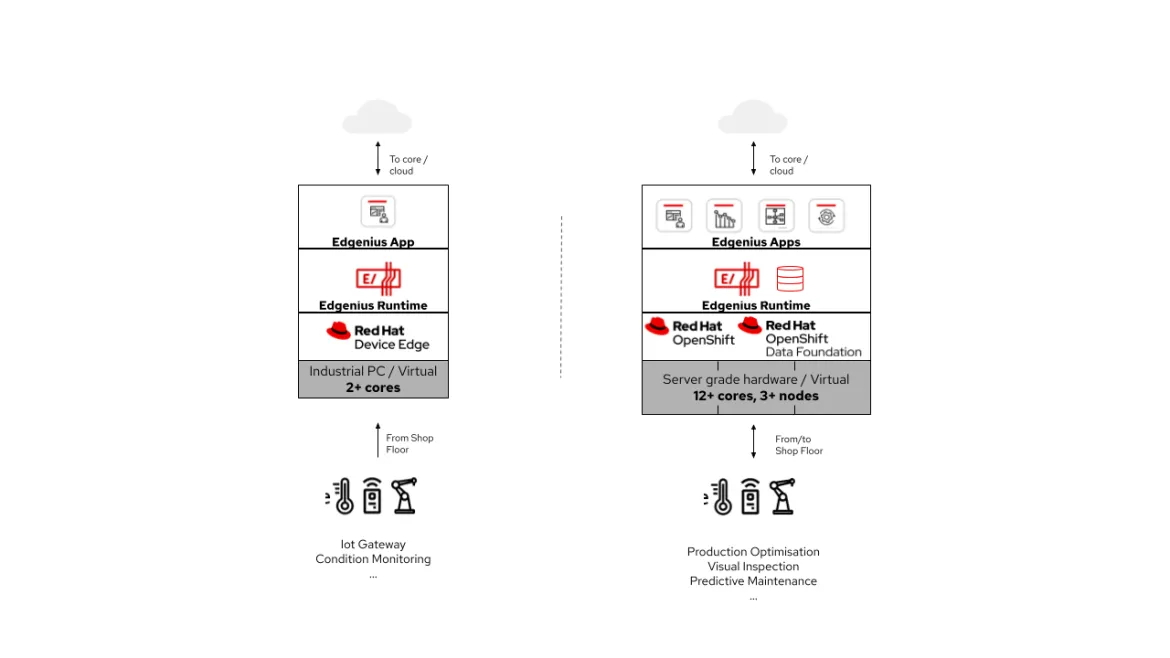Edge computing continues to push the boundaries and capabilities of modern information technology (IT). At the same time, operational technology (OT) requirements are becoming more and more aligned with IT. As a result, a paradigm shift is taking place in the industrial sector as manufacturers turn to open source technologies to support more agile operational technology (OT) platform architecture and capture real-time data insights at the edge. In fact, IDC predicts that by 2024, 30% of industrial organizations will have become leaner and more agile than their competitors as a result of making real-time operational insights available anytime, anywhere, to anyone1.
In response, last year Red Hat and ABB announced a global partnership to enable industries with process automation solutions backed by enterprise-grade open source technologies. Today, we are pleased to announce the latest milestone in our partnership with the availability of ABB Ability™ Edgenius™ on Red Hat OpenShift and Red Hat Device Edge (early access) to extend operational consistency for industrial use cases across edge and hybrid cloud environments.
The power of open source for industrial edge computing
Industrial controls are at the forefront of today’s edge computing-driven digital revolution. The systems that manage the operations of a power plant, a steel mill, a pharmaceutical company, or a food and beverage producer – all of these were traditionally designed as purpose-built systems. Data could be pulled from each system to allow basic management across the plant, but each system is still functioning essentially as a separate island.
As organizations move additional computing power to the plant floor, they are also realizing that the methodologies previously mastered by IT organizations over the last decade are just as relevant in an OT context. Therefore, Red Hat and ABB are working together to enable OT use cases using ABB process automation solutions on Red Hat’s open hybrid cloud portfolio to fuel next-generation OT offerings. For example, Red Hat and ABB solutions can be used in industrial environments to:
- Support low latency data extraction from control systemswithout interfering with the core control functionality to enable fast and secure supervision and cross-system optimization of physical equipment, processes and plants.
- Address security concerns by integrating security-focused features into the software supply chain to support protected device onboarding and apply more consistent policy management configurations to thousands of devices.
- Deliver more flexible features and functions with a faster time-to-market, using modern application development principles like microservices and event driven architecture.
ABB Ability™ Edgenius™ supports a variety of scenarios such as compute, connectivity and high availability. Because of this, ABB needs a flexible but consistent platform for a broad range of use cases, including industrial IoT gateways that can securely collect and carry data from production assets to the cloud, and condition monitoring to locally track asset health to ensure plant uptime. More advanced use cases, based on multiple interoperable applications hosted on Edgenius to optimize control settings of a plant, may require high availability to ensure continuous accessibility during production.

To meet these various industrial operational requirements at the edge, ABB will utilize the full spectrum of Red Hat edge platforms. Based on Microshift and Red Hat Enterprise Linux, Red Hat Device Edge supports the smallest footprint of edge devices and will help ABB to more easily connect cloud and control environments optimizing overall equipment efficiency (OEE) by aggregating and analyzing data on devices at hard to reach locations and with limited resources. In addition, the flexible image builder mechanism allows ABB to create their own edge operating system based on Red Hat Enterprise Linux.
Single node OpenShift, Red Hat’s smallest supported Red Hat OpenShift topology, equips ABB Ability™ Edgenius™ with a self-contained node to run at the edge in protected or connect-on-demand mode. This allows ABB to seamlessly extend applications where they are most needed - alongside remote IoT data sources such as sensors and generators - all without the need for constant, centralized connectivity. Furthermore, Red Hat OpenShift multi-node high availability deployment options offer greater scalability for edge workloads regardless of downtime requirements, even accommodating GPU acceleration for onsite image and video intensive workloads.
Learn more
Tune into the Red Hat Summit 2023 keynote on YouTube or LinkedIn to hear more from ABB and their recent work with Red Hat. Attending Red Hat Summit in person? Catch Red Hat and ABB’s session at 2p.m. ET on May 24th.
1IDC FutureScape: Future of Operations 2023 Predictions, October 2022, Doc #US48669222
About the authors
Francis Chow is currently VP & GM, In-vehicle Operating System and Edge at Red Hat. Previously, he spent five years at VMware and was VP, Operations, Business Development and Strategy of the Telco and Edge Cloud Business Unit. Prior to VMware, Chow spent about 20 years in the semiconductor industry in leadership roles spanning across Engineering, Corporate Development, Marketing and Sales, and was a VP/GM for a $1B P&L before venturing into the software world. Chow holds an MBA and an MSEE from University of California at Berkeley and a BSEE from Rensselaer Polytechnic Institute. He has seven US patents.
Bernhard Eschermann is Chief Technology Officer of Process Automation, Head of Process Control Platform, and a member of the Group Technology Leadership team for ABB since 2013. He joined ABB in 1993 and has held a variety of management positions within the company. Prior to his current role, he served as General Manager of Power Semiconductors for ABB from 2006 through 2012. From 2001 to 2006, he was Managing Director for ABB’s Corporate Research Center in Switzerland. Other roles included responsibility for R&D organizations in Substation Automation and Power Electronic systems. Outside of ABB, he is a board member of OPC Foundation and serves on the Innovation Council of Innosuisse, the Swiss federal agency for the promotion of innovation projects. He is also a member of Swiss Academy of Technical Sciences (SATW) and a member of the board of Hasler Foundation and Metall Zug AG.
More like this
Browse by channel
Automation
The latest on IT automation for tech, teams, and environments
Artificial intelligence
Updates on the platforms that free customers to run AI workloads anywhere
Open hybrid cloud
Explore how we build a more flexible future with hybrid cloud
Security
The latest on how we reduce risks across environments and technologies
Edge computing
Updates on the platforms that simplify operations at the edge
Infrastructure
The latest on the world’s leading enterprise Linux platform
Applications
Inside our solutions to the toughest application challenges
Original shows
Entertaining stories from the makers and leaders in enterprise tech
Products
- Red Hat Enterprise Linux
- Red Hat OpenShift
- Red Hat Ansible Automation Platform
- Cloud services
- See all products
Tools
- Training and certification
- My account
- Customer support
- Developer resources
- Find a partner
- Red Hat Ecosystem Catalog
- Red Hat value calculator
- Documentation
Try, buy, & sell
Communicate
About Red Hat
We’re the world’s leading provider of enterprise open source solutions—including Linux, cloud, container, and Kubernetes. We deliver hardened solutions that make it easier for enterprises to work across platforms and environments, from the core datacenter to the network edge.
Select a language
Red Hat legal and privacy links
- About Red Hat
- Jobs
- Events
- Locations
- Contact Red Hat
- Red Hat Blog
- Diversity, equity, and inclusion
- Cool Stuff Store
- Red Hat Summit


